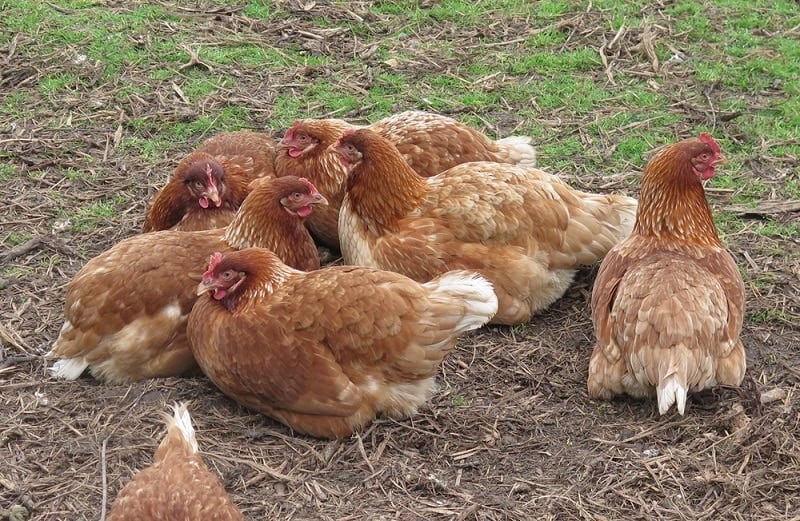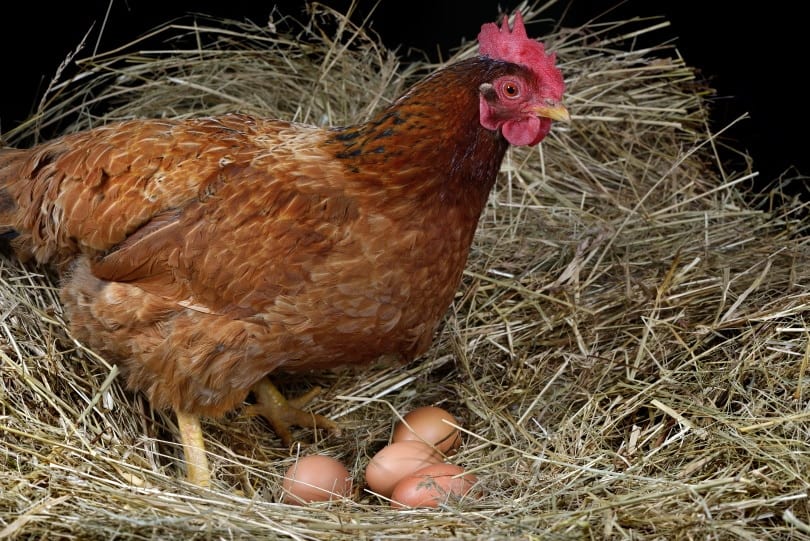Written by Dr. Luqman Javed
One of the most mysterious things about chickens is that they continue to lay eggs even if there are no roosters around to fertilize them. This behavior isn’t unheard of in birds, as many bird species can lay a clutch of eggs in the absence of a male.
Hens can lay an egg almost every day whether there is a rooster present or not. Chickens lay unfertilized eggs because the biological trigger to lay eggs does not involve the presence of a male, but rather, the amount of sunlight they’re exposed to.
Keep reading while we take a closer look at this strange behavior and discuss the difference between fertilized and unfertilized eggs, how many eggs are in a clutch, how many eggs a chicken can lay, and more to help you learn more about your flock.

Why Do Chickens Keep Laying Eggs?
The fundamental reason chickens produce eggs is because they are hardwired to do so from an evolutionary perspective. Chickens are prey to many animals, and therefore, it is important for them to be prolific. The answer in this comes from the ability to lay several eggs before deciding to incubate them. A hen that is incubating eggs is said to be broody during this phase, and up until she weans her chicks, she doesn’t lay eggs.
- The hen must be physically mature enough to lay eggs.
- The hen must have no underlying health issues that prevent the formation of eggs.
- The hen must be exposed to around 14 hours of daylight to trigger her reproductive cycle.
Hens will keep laying eggs until they either go broody or until daylight hours start decreasing. A broody hen will not lay eggs until her clutch of chicks is weaned. Typically, a hen that doesn’t go broody will only stop laying eggs for a few days before starting a new reproductive cycle. The aim of each cycle is to produce a clutch of eggs.
Layer breeds of chickens have been selectively bred for generations to be very prolific layers and very poor brooders. They almost never go broody and are known to produce more eggs than an average non-layer hen does.
Despite their prolific laying capacity, a layer hen cannot consistently produce an egg every day, as the average time it takes for an egg to form is 26 hours.

Fertilized Versus Unfertilized Eggs
There is no visual difference between a fertilized or unfertilized egg. When a hen mates with a rooster, she will produce fertile eggs. These fertile eggs will hatch if incubated in the correct conditions.
However, a fertilized egg will not begin the formation of an embryo until the proper incubation temperature and humidity criteria have been met. Therefore, if the poultry farmer collects the eggs every day and keeps them refrigerated, they will be indistinguishable from unfertilized eggs in appearance and flavor. However, molecular studies on fertilized and unfertilized eggs do reveal differences 1, probably due to the fertilized egg having precursors required for embryo development.
A common misconception is that fertilized eggs contain more cholesterol than unfertilized eggs; however, studies have shown that this isn’t necessarily true. There seem to be no significant differences in the cholesterol levels of the two egg varieties 2.
Interestingly, a hen that has mated with a rooster may produce a double yolked egg; however, the egg will not be viable and wont develop into a chick if incubated. Eggs that are deformed or misshapen also fail to hatch, despite being fertilized.
Signs of a Fertilized Egg

Fertilized eggs placed in an incubator or under a broody hen will begin to transform into a baby chicken, and the first signs will be a veiny structure inside the egg. It will take 3–4 days for the veiny systems to appear. These structures are usually visualized on day 5 of incubation by candling. Chicken eggs take 21 days to hatch. If the incubation period is abruptly halted or interrupted during the 21 days, the chick inside will no longer be able to continue forming. For this reason, a broody hen will incubate her eggs for about 23 hours per day, only leaving them for brief periods of time to quickly eat, drink, and evacuate her bowels.
How Many Eggs Can a Chicken Lay?
The average chicken likely produces about 600 eggs in total, but it can vary significantly from one breed to the next, and there are hundreds of breeds. There haven’t been significant studies on this matter, as many hens are retired and no longer used for egg production well before they truly stop laying eggs. Most hens reach their laying peak when they are around 12–24 months old. Their egg production tends to decline as they age past this limit. Older hens kept as pets eventually stop laying eggs.

Summary
Like many other birds, chickens have the ability to lay unfertilized eggs. The presence of a male is required to produce fertilized eggs; however, the other physiological triggers to lay an egg do not involve mating with a male.
There are no easily distinguishable differences between a fertilized egg and an unfertilized egg. A fertilized egg can be identified as viable after around 5 days of incubation. Hens will continue to lay eggs for as long as they are able to, with or without a male. At an average of 600 eggs per chicken, you get quite a bit from a single hen!
Featured Image Credit: thieury, Shutterstock
